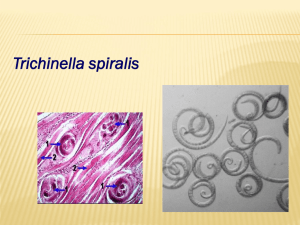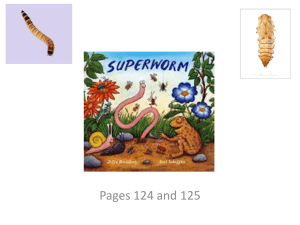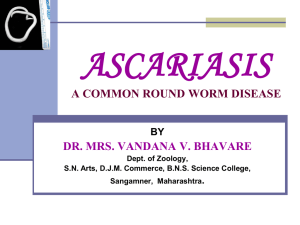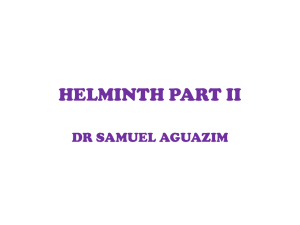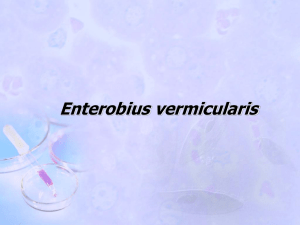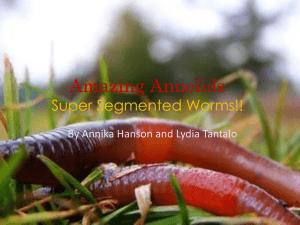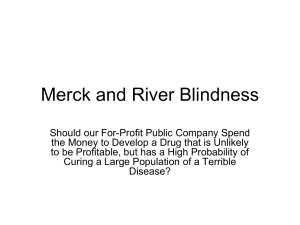Avermectins and the Battle against Onchocerciasis and Lymphatic
advertisement
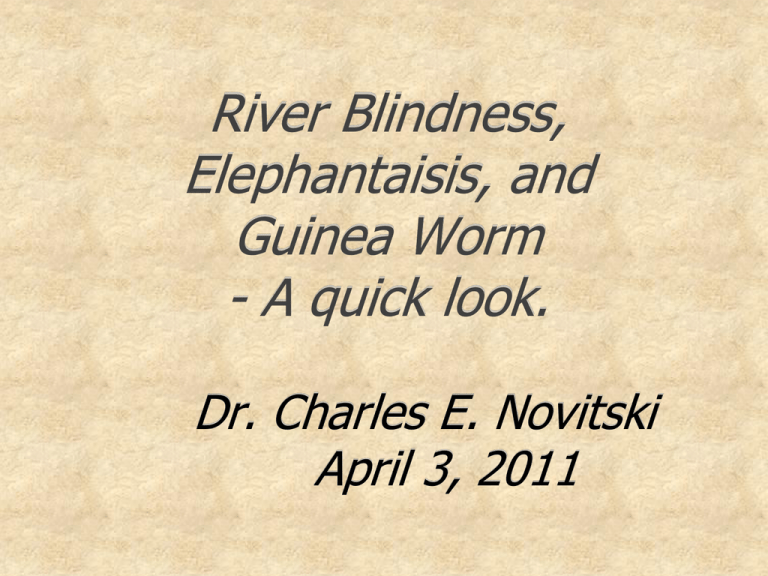
River Blindness, Elephantaisis, and Guinea Worm - A quick look. Dr. Charles E. Novitski April 3, 2011 Overview Today Earlier perspectives, avermectin and milbemycin. Merck & Co’s philanthropy. River Blindness (onchocerciasis) & Onchocerca volvulus; 1987. Elephantiasis (lymphatic filariasis) & Wuchereria bancrofti; 1998. Guinea worm disease & Dracunculus medinensis, 1986. Goal of permanent erradication. Previous Worked at Agrigenetics Advanced Sciences Company, Madison, Wisconsin. 1984-1988. First plant biotech startup company. Project goal: to protect plants against plant parasitic nematodes, avoiding standard chemical pesticides. Approaches: Strongly root-colonizing bacterium, Pseudomonas cepacia, method patented. (used commercially.) Mouse antibody genes expressed in transgenic plant cells, intending to disrupt feeding cell interaction. Funded work on dissecting genes for milbemycin pathway in Streptomyces species. Previous Observations at the time: (1) Avermectins (similar chemically to milbemycin) were identified by Merck in 1978. These were highly effective against some animal-parasitic nematodes, with low side effects. It was unfortunate that they were too expensive for people in poorer countries, who needed them. (2) Not unexpectedly, companies had the attitude that they cannot spend money developing a cure unless likely profits will more than pay for the development. Overview Today Earlier perspectives, avermectin and milbemycin. Merck & Co’s philanthropy. River Blindness (onchocerciasis) & Onchocerca volvulus; 1987. Elephantiasis (lymphatic filariasis) & Wuchereria bancrofti; 1998. Guinea worm disease & Dracunculus medinensis, 1986. Goal of permanent erradication. Merck & Co. Avermectins. Avermectins were identified by Merck in 1978 and published in 1979. These were highly effective against some animal-parasitic nematodes, with low side effects. Mectizan= ivermectin= avermectins B1a + B1b. Metabolite of the bacterium Streptomyces avermitilis. Recommended about 150-200 µg/kg body weight. Affinity for glutamate-gated and gamma-aminobutyric acid (GABA) gated chloride channels. Doesn’t cross the blood brain barrier in mammals, but interferes with neurotransmission in some stages in some nematodes. Avermectins B1a and B1b Merck & Co. Philanthropic step, 1987, by Merck & CEO Dr. Roy Vagelos: Agreed to donate Mectizan for as long as it takes to “control” onchocerciasis (river blindness). The scope of the commitment appears to be due in part to persuasion of former President Jimmy Carter. The funding behind the cost includes the River Blindness Foundation and the money of John Moores. And later also the Bill and Melinda Gates Foundation. And Lion’s Club and others. Overview Today Earlier perspectives, avermectin and milbemycin. Merck & Co’s philanthropy. River Blindness (onchocerciasis) & Onchocerca volvulus; 1987. Elephantiasis (lymphatic filariasis) & Wuchereria bancrofti; 1998. Guinea worm disease & Dracunculus medinensis, 1986. Goal of permanent eradication. River Blindness (Onchocerciasis) Short Film Clip: http://www.cartercenter.org/news/multi media/HealthPrograms/PreservingVision forFutureGenerations.html 3 minutes, 10 seconds. River Blindness (Onchocerciasis) Itchy skin rashes; nodules in skin Inflammation of the cornea, long term. Thickening of the corneal stroma. Leads to blindness Cause is infections by filarial nematode Onchocerca volvulus. Mectizan kills microfilariae. Mectizan does not kill adult worms, but does sterilize adult females. Adult worms do not cause symptoms. Onchocerca volvulus Filarial nematode. Black fly, genus Simulium, host. Microfilariae: gut to flight muscles. L1 larvae L2 larvae L3 larvae: to proboscis & salivary gland and into bite of human Obligate host: human L3 larvae into blood, to subcutaneous tissue, form nodules. Become Adults over 6-12 months. Then migrate to subcutaneous tissue to mate (males & females). Can live 15 years. Females produce 1000 to 3000 microfilariae/day. Microfilariae can live 1 to 2 years. Taken up by black fly bite blood meal. River Blindness Eradication Efforts 1987 Merck donations began. Merck donations extended to all needy communities. 530 million treatments. Bill & Melinda Gates Foundation recent help. Mectizan 150 µg/kg once a year sufficient for patients. Twice a year better for eradication. World eradication not currently likely, but in the Western hemisphere, eradication is planned by the Carter Center by 2012 or soon thereafter. Overview Today Earlier perspectives, avermectin and milbemycin. Merck & Co’s philanthropy. River Blindness (onchocerciasis) & Onchocerca volvulus; 1987. Elephantiasis (lymphatic filariasis) & Wuchereria bancrofti; 1998. Guinea worm disease & Dracunculus medinensis, 1986. Goal of permanent eradication. Elephantiasis (Lymphatic filariasis) Short Film Clip: http://www.cartercenter.org/news/multi media/HealthPrograms/AlleviatingSuffer ingEndingShame.html 4 minutes, 37 seconds. Elephantiasis (Lymphatic filariasis) Swelling of legs (& arms) due to damaged lymph system. Hardening and thickening of the skin, called elephantiasis. In Africa, the cause is a filarial nematode, Wuchereria bancrofti. Common vector in Africa is the mosquito genus Anopheles. In Asia, LF is also caused by nematodes Brugia malayi and Brugia timori. Wuchereria bancrofti Filarial nematode. Mosquito, genus Anopheles, host. Microfilariae: gut to flight muscles. L1 larvae L2 larvae L3 larvae: to proboscis & salivary gland and into bite of human Human host (or veterbrate host). L3 larvae migrate to lymphatic vessels and lymph nodules. Become Adults. Then migrate to subcutaneous tissue to mate (males & females). Can live several years. Females produce many microfilariae. Lymphatic Filariasis Elimination Efforts 1998 Merck donations began for lymphatic filariasis. Treatment is by Mectizan (Merck) 150 µg/kg plus albendazole (donated by GlaxoSmithKline), once a year. Plus bed nets to control mosquitos. Lymphatic Filariasis Control & Elimination Efforts 120 million people in 80 countries are infected. With 26 million treatments since 1998, infection rates have decreased 90%. Overview Today Earlier perspectives, avermectin and milbemycin. Merck & Co’s philanthropy. River Blindness (onchocerciasis) & Onchocerca volvulus; 1987. Elephantiasis (lymphatic filariasis) & Wuchereria bancrofti; 1998. Guinea worm disease & Dracunculus medinensis, 1986. Goal of permanent eradication. Guinea Worm (Dracunculiasis) Short Film Clip: http://www.cartercenter.org/health/gui nea_worm/mini_site/gallery.html 2 minutes, 34 seconds. Guinea Worm (Dracunculiasis) Painful sores appear. Female nematode Guinea worm larvae up to 3 feet long release larvae into water. Cause is the nematode, Dracunculus medinensis. The second host are copepods (crustaceans), that leave larvae in unclean water. Dracunculus medinensis Nematode. Copepod (crustacean), “water fleas”, host. L1 larvae from female nematode from human “eaten” by copepod. L2 larvae L3 larvae, released to water. Human host. L3 larvae in water penetrate stomach and intestine walls. Become Adults and mate (males & females). Males die. Females then migrate to subcutaneous tissue. After one year, females, from hole in skin, release L1 larvae when in contact with water. Cycle complete. Guinea Worm The Approach 1986 Carter Center began. Use of only clean water by cloth filtering out the water fleas, Or by water treatment (BASF-donated ABATE larvicide) against water fleas. Or water by well. Female worm removal from patient by stick. No drug treatment used for humans. No vaccines available. Guinea Worm Elimination Efforts 1986, 3.6 million cases in 20 countries. 2010, only 1797 cases in 4 African countries (Sudan, Mali, Ethiopia, and Ghana.) Down more than 99%. The Carter Center anticipates worldwide complete elimination of Guinea worm within a few years. This will be the second human disease ever completely eradicated, since small pox was eliminated permanently in 1979.

